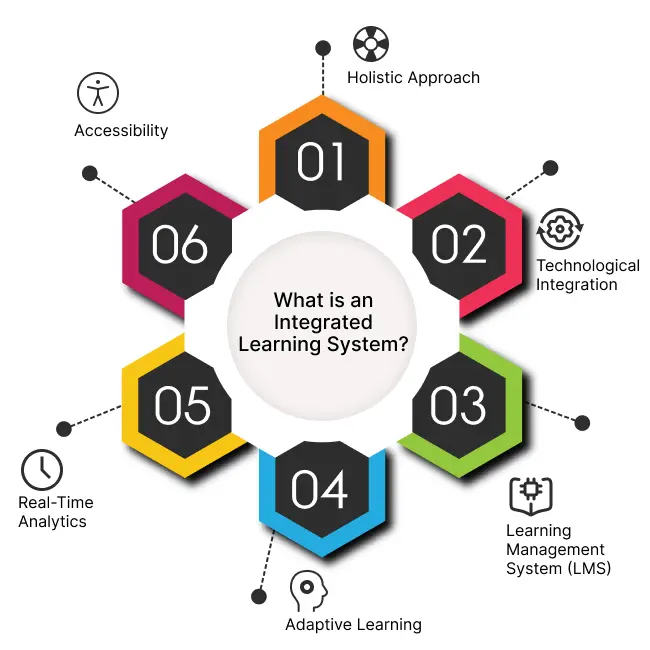03 July 2024
We need technology in every classroom and in every student and teacher’s hand, because it is the pen and paper of our time, and it is the lens through which we experience much of our world.
— David Warlick
This quote by David Warlick sheds light on how technology and our lives are connected. We live in a world where technology is as abundant as the air we breathe. This is why it is no surprise that technology has become an integral part of our modern education.
The digital tsunami has brought us to the age of the Integrated Learning System (ILSS). It has transformed the way college students learn, interact and grow.
In this blog, we will understand the characteristics of integrated learning systems and how integrated learning systems benefit college students. We’ll also look at how the Learning Management System (LMS) assists ILS.
But before jumping to benefits directly, let’s first understand
What is an Integrated Learning System?
An Integrated Learning System (ILS) is a complete learning framework that combines various educational technologies and methods, often computer-based and online, which is designed to deliver learning content to the students. These systems focus on organising educational resources and content for specific subjects to allow students access to them as they progress through the course.
Here is how an integrated learning system functions and contributes to the world of education:

-
Holistic Approach: An integrated learning system streamlines and provides a unified platform where all the learning resources are connected to each other. This system assists a variety of learning activities such as lectures, interactive sessions, and assessments, all in a single place.
-
Technological Integration: At its heart, ILS utilises the latest technology such as Artificial Intelligence (AI), Virtual Reality (VR), and Augmented Reality (AR). These technologies help in creating an immersive and personalised learning experience for the learners.
-
Learning Management System (LMS): The Learning Management System (LMS) lies at the heart of an Integrated Learning System (ILS). It is more than just a digital storehouse for course materials. An LMS also functions as a hub for managing student data, tracking progress, and establishing effective communication between educators and students.
-
Adaptive Learning: Integration of AI helps enhance the integrated learning system’s adaptability. ILS can adapt to every student’s individual learning styles and pace. This provides customised learning ways and resources to enhance understanding of course content.
-
Real-Time Analytics: ILS also allows educators to monitor student engagement and performance in real-time. This helps educators provide the right support and interventions at the right time.
-
Accessibility: Thanks to cloud-based technologies, an integrated learning system ensures that the educational content is accessible to learners from anywhere in the world, at any time, free from the limitations of geographical and time constraints.
The evolution of the Integrated Learning System is proof of the transformative power of technology in education. Now that we understand what an integrated learning system is, let's move ahead.
How LMS Software Enhances Student Learning?
Read More
Characteristics of an Integrated Learning System
Integrated Learning Systems are designed to create a rich educational environment that helps in developing various essential skills. Here are some of the characteristics that define an Integrated Learning System:
Problem Solving
ILS platforms are actively integrating >Gamification and Interactive Learning Experiences for students to enhance problem-solving skills. By dealing with challenges in a gamified context, students feel more motivated to engage with the content on a deeper level and solve complex problems.
Real-world simulations have also been brought into use to help students apply what they've learned in practical, unpredictable situations. These simulations provide context to theoretical knowledge, allowing students to use their learning in real-life scenarios.
Curriculum Integration
The latest ILS models use big data analytics to connect different subjects in the curriculum. This helps students understand how subjects relate to each other and how they can use this knowledge in various areas
Faculty development programs now emphasise creating connections across different subjects. This ensures that teachers are prepared to guide students through a curriculum that integrates multiple disciplines
Application of Information
ILS promotes learning through project-based activities. Students learn through working on projects that involve research, planning, and execution, similar to real-world tasks.
Students get real-world experience by doing internships and fieldwork as part of their education. This helps them apply what they've learned in a practical way
Creativity and Collaboration
Students are encouraged to brainstorm and think innovatively through collaborative projects to nurture their creativity. Digital tools that enable efficient communication and idea-sharing with peer support in this process
The introduction of technologies such as Virtual Reality (VR) and Augmented Reality (AR) has led to immersive experiences to encourage creative thinking and collaboration.
Accommodates Learning Styles:
Integrated Learning Systems now use Adaptive Learning Technologies that personalise the learning experience for students to fit their learning styles and paces.
Multimedia resources like videos, podcasts, and interactive modules are designed and used for visual, auditory, and kinesthetic learners. This ensures that every student can learn in the way that suits them best.
These characteristics bring a spotlight on the adaptability and forward-thinking nature of ILS. With these characteristics, educational institutions can provide a learning experience that prepares students for the challenges of the modern world.
Benefits of Integrated Learning Systems for Students
Adopting Integrated Learning Systems in Educational institutions has been proven to be a game changer for the development of students. Here are some benefits that students enjoy from Integrated Learning System:
Increased Engagement
Interactive Learning: ILS keeps students engaged and attentive with interactive modules and simulations. This makes learning an active experience for students.
Relevance to Real Life: By showing how the theories learnt by students can be applied in the real world, ILS makes education more relevant. This gives a boost to student engagement and curiosity.
Greater Understanding
Interconnected Knowledge: With ILS, Students understand the interrelation between different subjects. This helps students develop a detailed understanding of the concepts that go beyond isolated facts.
Long-Term Retention: The interconnections also help students retain the information they have learned for a longer period of time. This is because they can connect the information to a larger framework.
Transferable Skills
Versatile Skill Set: With ILS, Students develop skills such as critical thinking and problem-solving which help them deal with situations across various fields.
Teamwork and Communication: The collaborative projects in ILS platforms also help students enhance their ability to work in teams and communicate effectively.
Improved Motivation
Goal-Oriented Learning: Motivation comes with the understanding of the purpose. Students feel more motivated when they understand the purpose behind their studies. ILS aligns the academic goals with the personal and professional aspirations of the students
Self-Directed Learning: ILS encourages students to take the initiative and lead their own learning journey. This develops a sense of control over their lives and encourages students to think critically which increases their motivation.
Enhanced Creativity
Innovative Thinking: ILS creates an environment students are encouraged to think outside the box and give a creative approach to solving problems.
Diverse Perspectives: Exposure to multiple subjects and disciplines develops a wide range of perspectives which enhances creativity
Now that you understand what Integrated Learning System is and how it benefits students, Let's move on to the final part of our article,
How Learning Management Systems (LMS) Assist in an Integrated Learning System
Learning Management System (LMS) holds a very important role in supporting and enhancing Integrated Learning Systems. LMS lies at the heart of ILS, assisting in its process.
Here are some ways that a Learning management system (LMS) contributes to the success of an integrated educational approach:
1. Centralised Platforms
The learning management system acts as a centralised hub where both students and teachers can easily access a wide range of educational resources. From lecture notes and textbooks to multimedia content and interactive modules, everything is conveniently located in one place.
With a Cloud-based Learning Management System (LMS), students can easily access these resources from any time and anywhere, irrespective of whether they are on campus or off-site. This accessibility helps provide a seamless learning experience.
2. Tracking and Assessment
A Learning Management System (LMS) also allows teachers to track student progress throughout the learning journey. Teachers can easily monitor student engagement levels and their performance on assignments and assessments.
Integrated assessments within the Learning Management System (LMS) provide teachers with a complete view of students' performance. This helps teachers identify areas where students are doing well and areas where they need to improve. It also allows teachers to provide focused support where it's needed.
3. Collaboration Tools
Learning Management Systems offer multiple collaboration features which include discussion forums, chat rooms, and group projects. These tools enable peer-to-peer interaction and knowledge sharing.
Students work together with their peers, share ideas, and learn from different perspectives. Collaborative learning is an important part of education and helps improve critical thinking and problem-solving skills.
4. Customisation
Teachers can customise learning experiences in the LMS to fit each student's needs. This can include changing the pace of teaching, offering extra materials, or creating specific assignments. Learning Management System (LMS) platforms make it possible to personalise the learning experience.
Customisation helps in ensuring that students receive the support they need, whether they are advanced learners looking for extra challenges or students who need more help.
The Role of LMS Software in Schools and Universities
Read More
5. Resource Integration
A Learning Management System smoothly integrates multimedia resources into the learning process. Elements like videos, simulations, e-books, and interactive modules enhance the quality of educational content.
Students benefit greatly from a varied learning experience, which takes them beyond traditional textbooks to engage with dynamic, visual, and interactive materials.
6. Accessibility
Learning Management System (LMS) platforms are accessible 24/7 to students. They can access learning material as per their requirements at their convenience. It doesn’t matter whether they're studying during regular hours or burning the midnight oil; learning material is always available at their fingertips.
The accessibility provided by LMS supports a diverse learning environment, including remote and hybrid learning. Learning Management Systems (LMS) ensure that education is free from the bounds of physical constraints and meets the requirements of students across the globe.
Conclusion
In a nutshell, a Learning Management System (LMS) is the backbone of an Integrated Learning System. It provides a structure for content delivery, assessment, collaboration, customization, resource integration, and accessibility.
As technology continues to evolve, LMS platforms will remain crucial in creating effective and engaging learning experiences for students worldwide.
End Note
Integrated Learning System plays a very crucial role in improving the education in our society.
With the characteristics and benefits mentioned in this article along with the assistance of Learning management systems (LMS), integrated learning systems bridge the gaps between the subjects and students preparing for this challenging world.
It is time for every educational institution to upgrade themselves, adopt integrated systems and create a brighter and more promising future for college students globally.

Gaurav Somani,
Academic Consultant